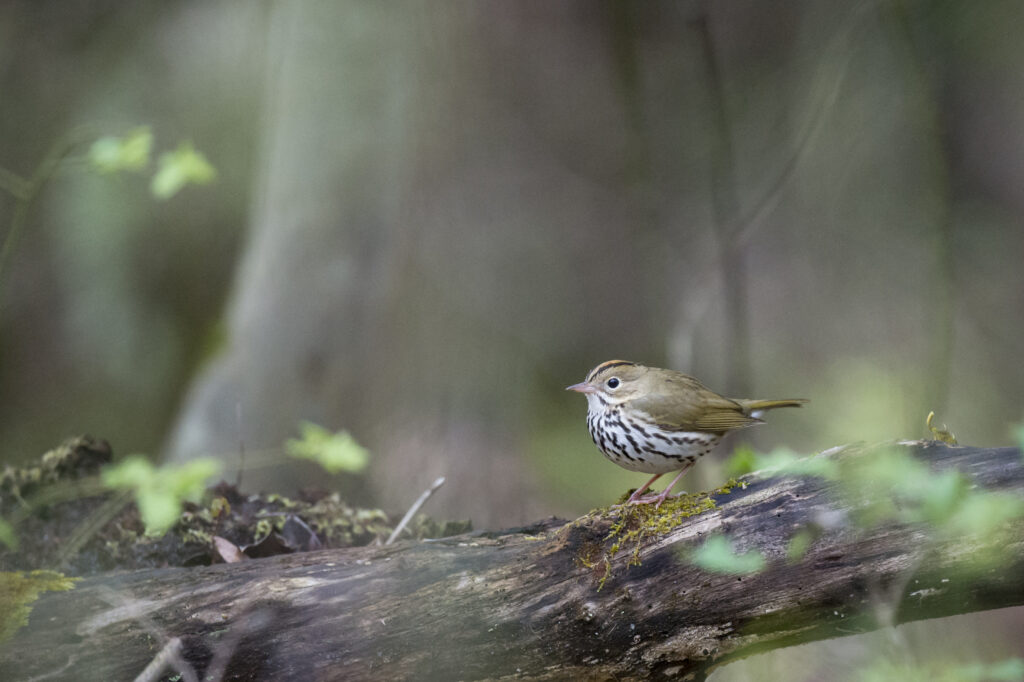There is a singer everyone has heard,
— Robert Frost “The Ovenbird”
Loud, a mid-summer and a mid-wood bird,
Who makes the solid tree trunks sound again.
He says that leaves are old and that for flowers
Mid-summer is to spring as one to ten.
He says the early petal-fall is past
When pear and cherry bloom went down in showers
On sunny days a moment overcast;
And comes that other fall we name the fall.
He says the highway dust is over all.
The bird would cease and be as other birds
But that he knows in singing not to sing.
The question that he frames in all but words
Is what to make of a diminished thing.
An inspiration for poets and a source of confusion for beginning birders, the Ovenbird is a slightly large warbler with a tan upper body and a cream-colored belly and neck streaked with black feathers. This plumage pattern is the reason so many new birders have a hard time with the Ovenbird. Although it is a warbler, the Oven bird looks like a close sibling to several of the brown and cream streaked members of the thrush family, including the Wood Thrush, Hermit Thrush, and Swainson’s Thrush. These birds are notoriously difficult to tell apart and their similarities to the Ovenbird doesn’t make things any less confusing.
Despite its appearance, the Ovenbird is not a close relative of the thrush family at all. Though they are larger than usual for the family, Ovenbirds actually belong to the Parulidae, also known as the “New World warblers.” Even within their own family, though, Ovenbirds are unique. The scientific name for the Ovenbird is Seiurus aurocapilla, meaning “shake tail” and “golden-haired.” The Ovenbird is the sole member of the Seiurus genus, which is thought to be the oldest genus to split form the rest of the Parulidae family.
Related Article: The 2023 Christmas Bird Count is Coming: Here’s How You Can Participate
Fun Facts About the Ovenbird
Unique in name and in evolutionary history, the Ovenbird is a common woodland bird with a lot of fascinating secrets to share. Let’s take a look at some Ovenbird fun facts to learn what makes these birds so very special!
Buns in the oven: To start off, where does the name “Ovenbird” come from? You might not expect the answer. Unlike most songbirds who build their nests in trees or shrubs, the Ovenbird builds a nest on the ground. Ovenbird nests are odd dome-like structures with an entrance at the side. Though they’re built from dead leaves and sticks, Ovenbird nests look pretty similar to a Dutch oven or a bread oven thanks to that dome shape and side entrance.
Protective theatrics: Some birds protect their nests by putting on a show. The Killdeer is the most famous example of this. Because Killdeer nests are mere scrapes on the ground, mother Killdeer must risk life and limb to protect their young by acting injured and luring away and distracting would-be predators. The Ovenbird’s nest is a bit more involved than a simple scrape on the ground, but like the Killdeer, mother Ovenbirds perform fake injuries when predators approach their nests. Because they are ground-nesting birds, Ovenbird chicks face significant risks from all manner of terrestrial predators.
A walk in the woods: Any birdwatcher who has spent time walking through the woods and watching the warblers forage knows that these dainty little birds zip from tree trunk to shrub to branch. The Ovenbird doesn’t quite look like other warblers, but, perhaps more strangely, it doesn’t really act like them either. Ovenbirds are more often seen walking from place to place. Early ornithologists have even described their strut as resembling a miniature chicken!
The Future of the Ovenbird
The Ovenbird is listed as “Least Concern” on the International Union for Conservation of Nature’s Red List of Threatened Species. The list also notes that Ovenbird populations are currently stable in most of their range.
Popular Article: New Zealand’s Bird of the Century Crowned

